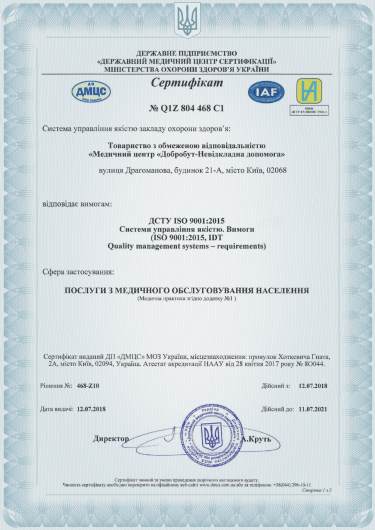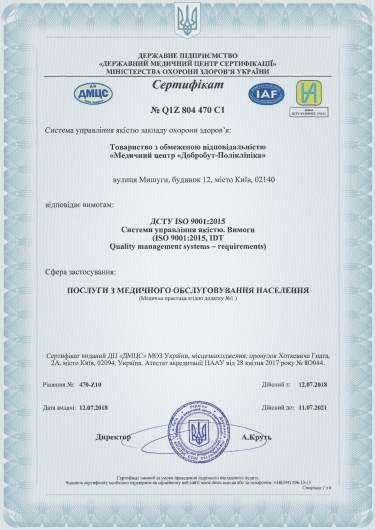Removal of malignant tumors
In oncology, surgery is often used as radical treatment.
Removal of the tumor may be accompanied by removal of the affected organ or part thereof, thereby minimizing the effects of cancer.
What is cancer (malignant tumor)?
A malignant tumor is a formation in the human body with a very aggressive nature, and extremely dangerous to health.
Such neoplasms appear due to the so-called "bad" cells and their continuous proliferation.
It is known that a malignant tumor has the ability to move to neighboring and distant human organs. If such a change is introduced into the tissue, it is possible to tolerate invasions (germination). In this case, the tumor itself begins to absorb the surrounding tissues.
The following features are characteristic of a malignant tumor:
- It can hide from immunological control.
- The tumor can enter the surrounding tissues, forming metastases.
- A malignant tumor can develop and grow very quickly, which causes compression of the surrounding tissues. The development process can take several weeks. At the same time acute hemoblastosis, being in a blast crisis grows every day.
- The cells have a low coefficient of "maturity". There is a dependence: the tumor is more aggressive when the cell is practically not formed.
- Metastasis can occur far from the main formation.
After the planned life cycle, a healthy cell ceases to exist. In the case of a malignant cell, its life cycle is not defined, it can multiply constantly.
At formation, toxins are made. They damage the immune system, which is aimed at treatment. In these patients there is intoxication, and even the level of hemoglobin decreases.
The person loses weight, in some cases to cachexia (exhaustion).
When can malignant tumors be removed?
- the tumor does not extend beyond the organ;
- the tumor has clear boundaries;
- the tumor grows relatively slowly,
- tumor tissue retains the structure and function of the original tissue;
- the tumor arose under the influence of external factors;
What are the contraindications to the removal of malignant tumors?
Surgery is not performed if an elderly patient is burdened with chronic diseases of the heart, lungs, liver, kidneys, which cause his general serious condition.
However, in the hospital, the functional performance of such patients can be improved, and then return to the discussion of the feasibility of surgery.
What are the principles for the removal of malignant tumors?
Ablastics
To prevent tumor recurrence, the principle of ablastics is used in oncology.
At surgical intervention from healthy fabric, all tumoral elements together with a complex of lymphatic vessels and knots are removed. Manipulations are carried out very carefully, without squeezing and injury, removal occurs in a single unit, the tumor is removed as if in a "case" from healthy tissues, blocking the path for the spread of pathological cells.
There is no visible boundary between healthy and cancer cells. Therefore, the experience, qualifications, skill, and intuition of the oncologist surgeon come to the fore in this battle on the operating table.
Antiblastic
Thus, adherence to the principle of antiblasticity is the use of a set of techniques that help prevent the scattering of cancer cells outside the tumor and the operating field. These techniques are the physical and chemical effects on the body during surgery. These include:
frequent changes of tools and consumables;
washing the wound with antiseptics;
use of chemotherapy and radiation therapy before, during, or after surgery;
use of laser, electrocoagulation (high-frequency electric cauterization), and cryodestruction (exposure to ultra-low temperatures).
Applying the principles of ablastics and antiblastics, oncologists also solve the following task: to minimize the harmful effects on healthy tissues and organs.
How are surgical interventions performed for malignant tumors?
The choice of the type of surgical intervention is determined by its purpose:
- to eliminate the cause of the pathological process;
- to restore the injured organ;
- relieve cancer symptoms, improve quality of life;
- clarify the diagnosis.
In this regard, operations for cancer patients are divided into:
- radical;
- reconstructive;
- palliative;
- diagnostic.
Any surgical intervention is a dangerous and responsible stage of treatment, which is strictly justified.
At radical operation, the tumor together with the affected body or its part is removed. For example, the liver has a high ability to regenerate, it can restore the former volume in a relatively short time, so with liver cancer, the surgeon can, without fear of disruption of the body, remove part of this organ.
Radical operations to remove cancerous tumors are different. Thus, in a typical operation, to prevent the development of metastases, the tissues are removed together with the adjacent lymphatic system. But sometimes circumstances force including in the block of the removed fabrics additional groups of lymph nodes. Such a radical operation is called advanced.
Combined radical surgery is performed when the pathological process has affected neighboring organs.
There is also such a thing as "organ-sparing surgery". It is relevant, for example, for women diagnosed with early-stage breast cancer.
Reconstructive surgery is required for complete removal of the mammary glands: the appearance of the organs is restored. In the aggressive form of gastric cancer, removal of the organ may be indicated: then, to restore function, plastic replacement of the stomach with the patient's own tissues is performed. Reconstructive surgery can be effective in locally advanced laryngeal cancer. Due to such surgical interventions, the rehabilitation time of patients is reduced.
Palliative surgery is performed when the malignant tumor has not remained within its borders and cancer cells have begun to spread throughout the body, developed metastases that can not be completely removed. There is a need to eliminate complications caused by inoperable tumors. The goal is to restore vital functions of the body.
In this case, oncology surgeons can improve the patient's well-being. They stop bleeding, reduce intoxication of the body, restore patency, eliminate compression of internal organs, reduce pain. Thereby improving the quality of life.
To confirm or refute the diagnosis, are performed diagnostic operations, accompanied by the collection of material for histological examination.
Today, oncology allows three ways to treat malignant tumors:
Radiation therapy involves the effect of radiation on the cause of malignancy.
Chemotherapy refers to medical treatment. Such drugs are characterized by detrimental effects on tumor cells.
The surgical method of treatment prevents formation by surgery.
There are types of pathologies that can not be cured by only one of these methods. For this reason, a combination is often used.
What is the prognosis after the removal of malignant tumors?
Our clinic has many ways to get rid of a malignant tumor. There is no universal way. Therefore, each case is considered by us individually. Much depends on the stage of development of the malignant tumor, comorbidities, the spread of the cancer process, and many other factors.
For the effect of the treatment to be as effective as possible, it is necessary to follow all the recommendations given to the patient by his personal doctor. In this case, you can avoid recurrences and achieve recovery. After the operation, you need to be re-examined after some time, also prescribed by a doctor. This allows you to check the patient's condition and monitor his recovery. If the malignancy is detected again, additional procedures are prescribed. For these reasons, it is important to be examined on time so that oncologists can remove the malignancy promptly without spreading it to other vital organs of the human body.
What surgeries are performed in our clinic to remove malignant tumors?
In thyroid cancer:
- Crail's operation for tumor (radical lymph dissection of the neck);
- Simple thyroidectomy;
- Radical thyroidectomy;
- Partial thyroidectomy (hemithyroidectomy).
In lung cancer:
- Segmental resection of the lung;
- Lobectomy (removal of the entire lobe);
- Pulmonectomy (removal of the entire lung);
- Lymph dissection (removal of lymph nodes).
With gastric cancer:
- Gastrectomy;
- Gastric resection.
In liver cancer:
- Liver resection.
- In pancreatic cancer:
- Resection of the pancreas.
In cancer of the small intestine:
- Radical resection of the small intestine
In cancer of the colon, sigmoid colon:
- Hemicolectomy;
- Resection of the colon;
- Obstructive resection of the colon.
In rectal cancer:
- Resection of the rectum;
- Transanal endoscopic resection of the rectum with anastomosis (TAMIS-TME);
- Transanal endoscopic resection of the mucosa (TEM).
In breast cancer, nipple cancer (Paget's cancer):
- Radical mastectomy;
- Radical mastectomy with a plastic prosthesis;
- Radical resection of the breast (lumpectomy) (with or without sentinel lymph node biopsy);
- Supraclavicular lymph dissection;
- Axillary lymph dissection.
In cancer of the uterine body (cancer of the endometrium adenocarcinoma), ovaries:
- Pangysterectomy;
- Inguinal-iliac lymph dissection.
In cervical cancer:
- Radical trachelectomy.
In prostate cancer:
- Neuro-preserving radical laparoscopic prostatectomy for prostate cancer;
- Transurethral resection of the prostate in prostate cancer;
- Non-nerve-preserving radical posterior prostatectomy for prostate cancer;
- Nerve-preserving radical extradulon prostatectomy for prostate cancer.
In bladder cancer:
- Bipolar TUR of bladder tumors;
- Resection of the bladder wall with open access;
- Eradication of the bladder in bladder cancer;
- Pelvic lymphadenectomy with open access;
- Laparoscopic pelvic lymphadenectomy.
With kidney cancer:
- Removal of tumors of the retroperitoneal space;
- Kidney resection laparoscopically;
- Kidney resection from open access;
- Peritoneal retroperitoneal lymphadenectomy;
- Laparoscopic retroperitoneal lymphadenectomy;
- Open access nephrectomy;
- Laparoscopic nephrectomy.
In testicular cancer:
- Radical orchiectomy inguinal access.
In penile cancer:
- Radical penectomy with inguinal lymphadenectomy;
- Penectomy is partial.
At malignant educations of a jaw:
- Removal of a tumor of a jaw.
In spinal cord tumors:
- Removal of intradural extramedullary tumor (spinal cord);
- Removal of intradural extramedullary tumor (spinal cord) with spinal stabilization.
- In skin cancer (melanoma):
- Extensive excision of a malignant skin tumor;
- Extensive excision of a malignant tumor of the skin with plastic defect by local tissues;
- Extensive excision of a malignant tumor of the skin with a plastic defect with a free skin flap.
Bibliography
- Steven A. Goldman, Sana Biotechnology, Nimish A. Mohile - Опухоли спинного мозга. Last updated, June 2018.
- Алексеев Б. Я., Калпинский А. С., Поляков В. А., Андрианов А. Н. Лапароскопическая резекция почки при опухолевом поражении. Онкология. Журнал им. П.А. Герцена. 2012;1(1):4-9.
- Фигурин К.М. Злокачественные новообразования почечных лоханок и мочеточников. Онкоурология. 2006;2(2):5-12.
- Аляев Ю.Г., Винаров А.З., Крапивин А.А. Диагностика опухоли лоханки и мочеточника. В кн.: Тезисы VI Всероссийской научно-практической конференции Актуальные вопросы лечения онкоурологических заболеваний 4-5 октября 2005 г. Онкоурология (приложение) 2005: прил.: 5-6.
- Abdul-Muhsin H, et al. Analysis of benign prostatic hyperplasia patients' perspective through a third-party administered survey. Urology. 2016;88:155.
Our advantages
Our doctors
Dobrobut Clinical Oncology Center
ISO certification



Accreditation certificates



Medical practice licenses















%402x.png)
%402x.png)
